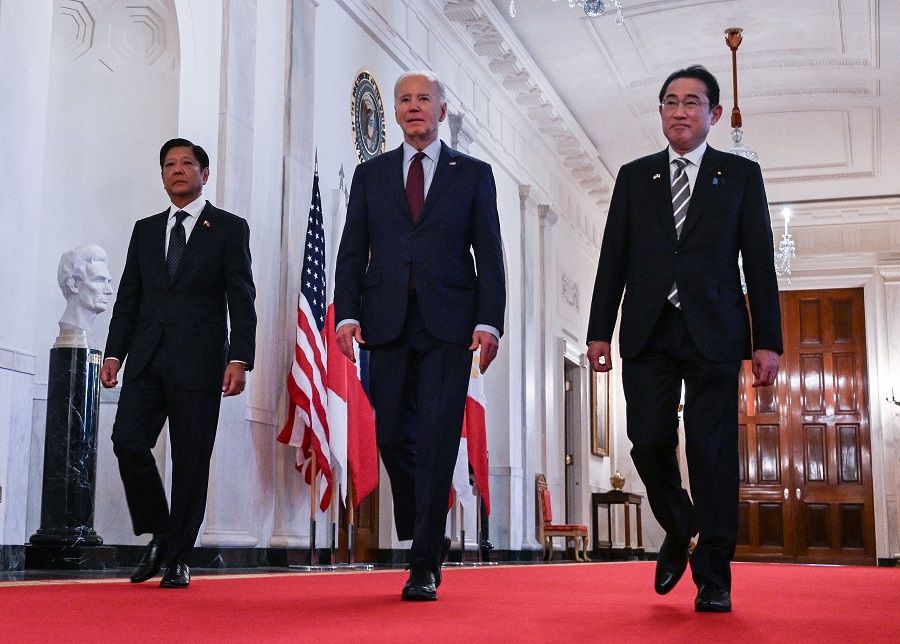US's 'Typhon' missile system deployed in the Philippines: A dangerous move?
Lianhe Zaobao associate editor Han Yong Hong notes that the deployment of the US's "Typhon" missile launcher system in the Philippines might lead to heightened tensions with China, as well as the risk of disunity within ASEAN, as alignments may shift.

Shortly after the closely-watched US-Japan-Philippines trilateral summit, the US Army Pacific Command announced on 15 April that the 1st Multi-Domain Task Force (1st MDTF) successfully deployed the "Typhon", a new midrange ground-based missile launcher system, in Northern Luzon, Philippines, as part of the US-Philippines joint military exercise "Exercise Salaknib 24".
The press release by the US military described the deployment as a "historic first", which would enhance interoperability, readiness and defence capabilities for both the US and Philippines militaries. For China, this is undoubtedly a move by adversaries to position threatening weapons directly at their doorstep.
Following the announcement, the defence chiefs for both China and the US, China's Minister of National Defence Dong Jun and US Defence Secretary Llyod Austin, shared a phone call on the night of 16 April, the first between the two in nearly 18 months, which is a proof that China and US militaries have fully resumed dialogue.
In the press releases for both sides, there was no mention of "Typhon", but both reiterated their stances with regard to the South China Sea and the Taiwan Strait issues with strong language, once more demonstrating that the South China Sea and the Taiwan Strait have become the most sensitive issues between the two militaries, and that one issue could affect the other.
The US military leveraged the joint military exercise to deploy "Typhon" on Luzon, which means the entire South China Sea, the Taiwan Strait, and China's eastern key coastal cities are all within range.
A historic first
That the US Army Pacific Command called the deployment of "Typhon" at Luzon, Philippines a "historic first" was no exaggeration, as it was indeed the first time since the Cold War that the US is deploying a midrange missile launcher system in Asia and on the first island chain.
Since 1987 when then US President Ronald Reagan and Soviet Union General Secretary Mikhail Gorbachev signed the Intermediate-Range Nuclear Forces Treaty, both the US and Soviet Union have destroyed more than 2,600 deployed and undeployed midrange missiles in accordance with the treaty, and have been subjected to restrictions on further production, development and deployment.
However, in 2019, then US President Donald Trump officially withdrew from the treaty, citing Russia's longstanding breach of the treaty and the fact that China was not a party to it. At the time, many predicted that the US would go all out to deal with China once it withdrew from the treaty.

"Typhon" is a direct result of the US's withdrawal from the Intermediate-Range Nuclear Forces Treaty, and it officially became combat-capable last year. The system is designed to launch various "Tomahawk" cruise missiles and "SM-6" missiles to hit targets on land, with a "tactical Tomahawk" missile range of up to 1,800 km.
The US military leveraged the joint military exercise to deploy "Typhon" on Luzon, which means the entire South China Sea, the Taiwan Strait, and China's eastern key coastal cities are all within range. The "Tomahawk" cruise missile can also be equipped with a nuclear warhead, increasing its deterrent effect.
In fact, when US Army Pacific commander General Charles Flynn visited Japan in April, he revealed to the media that the US planned to deploy in the Indo-Pacific region a midrange missile launcher system to strengthen their deterrence against China.
External observers have been guessing where the US would deploy the system, as well as which country would be willing to risk directly offending China. When the THAAD missile system was deployed in the Republic of Korea years ago, China retaliated severely. Which country would bear the brunt of "Typhon" this time around? Most commentaries guessed it would be deployed in Guam, or at most in Japan - no one thought it would be the Philippines.
The Philippines' pro-US stance could be due to the fact that Philippine elites are more influenced by the West, and also related to rising China-Philippines tensions over the Ren'ai Reef (also known as the Ayungin Shoal or the Second Thomas Shoal) in the South China Sea.
Pro-US vibes
Among the ten ASEAN countries, the Philippines is the most pro-US. The recently concluded State of Southeast Asia survey conducted by ISEAS - Yusof Ishak Institute found that, if forced to align itself with either China or the US, more ASEAN countries chose China than the US for the first time this year. Yet, it was the opposite for the Philippines - a whopping 78% of Philippine respondents had already chosen the US in 2023, and this figure again rose to 83% this year. Notably, while this survey is not a formal poll, since it is conducted annually, it reflects the geopolitical perspectives of the elites in ASEAN.
The Philippines' pro-US stance could be due to the fact that Philippine elites are more influenced by the West, and also related to rising China-Philippines tensions over the Ren'ai Reef (also known as the Ayungin Shoal or the Second Thomas Shoal) in the South China Sea.
Also, compared with large ASEAN countries such as Indonesia as well as Malaysia which have large Muslim communities, Muslims only make up about 5% of the Philippine population, and the damage to the US's image as a result of the Israel-Hamas conflict has had little impact on the Philippines.
This will certainly put pressure on the unity of ASEAN.

On the other hand, just as the US is strengthening military and economic cooperation with the Philippines, China warmly welcomed Indonesia President-elect Prabowo Subianto, while Chinese Defence Minister Dong visited Vietnam, another claimant state in the South China Sea, and agreed to establish a hotline between the Chinese People's Liberation Army's Southern Theater Command and the Vietnamese Navy.
Chinese Politburo member and Foreign Minister Wang Yi also visited Indonesia, urging ASEAN to band together from within and "resist all kinds of acts that create division and confrontation in the region", seemingly in reference to strengthening Philippines-US relations. This will certainly put pressure on the unity of ASEAN.
... the intensity of the criticism is far from China's reaction to South Korea's THAAD deployment back then. The reason for this, simply put, is because land-based Tomahawk cruise missiles are not as much of a threat as Tomahawk missiles launched by the US Navy or Air Force.
China and US still talking
Fortunately, shortly after the US military's aforementioned announcement, Chinese and US defence ministers Dong and Austin spoke via video teleconference on 16 April.
At the same time, China's response to the deployment in the Philippines has not been strong so far. The Chinese foreign ministry expressed "grave concern", while the defence ministry criticised this as a "dangerous move that will seriously threaten the security of regional countries and undermine regional peace and stability".
Even so, the intensity of the criticism is far from China's reaction to South Korea's THAAD deployment back then. The reason for this, simply put, is because land-based Tomahawk cruise missiles are not as much of a threat as Tomahawk missiles launched by the US Navy or Air Force. Last July, some Chinese military experts had already questioned if the US Army's deployment of Typhon was just using countering China as a cover to compete with other US military branches.

Regardless, diplomatic warfare and mutual military deterrence among major powers in the region, including the small multilateral military security cooperation promoted by the US, will increase regional tensions. The annual US-Philippines Balikatan or "shoulder-to-shoulder" military exercises mobilising some 17,000 troops will be held next week, and for the first time, in waters outside Philippine territory and areas caught between the sovereignty claims of China and the Philippines, clearly targeting China.
At the same time, US Secretary of State Antony Blinken will be embarking on his four-day China visit on 23 April, again repeating the US's strategy of engaging in negotiations with China while also employing containment measures. The US and China have been repeatedly engaged in this dangerous balancing game recently, but hopefully both parties can remain calm, keep the situation under control, and prevent any accidental mishap that could destabilise the situation.
This article was first published in Lianhe Zaobao as "美国"堤丰"中导系统部署菲律宾".



![[Photos] Fact versus fiction: The portrayal of WWII anti-Japanese martyrs in Taiwan](https://cassette.sphdigital.com.sg/image/thinkchina/3494f8bd481870f7c65b881fd21a3fd733f573f23232376e39c532a2c7593cbc)

